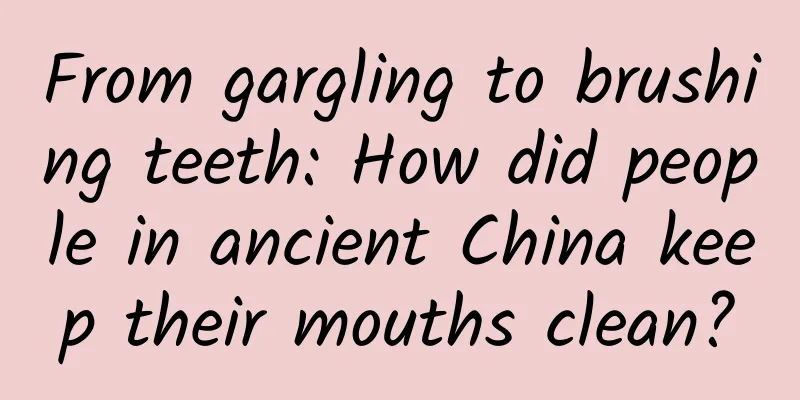From gargling to brushing teeth: How did people in ancient China keep their mouths clean?

|
Speaking of oral health, it seems that more and more people have oral problems in recent years. Some people think that this is due to economic progress. In fact, this is a wrong idea, because dental problems have existed since ancient times. Don't disbelieve it. Today, let's talk about oral health issues starting from the dental problems of the ancients. 01. Why do we say that ancient people also had dental problems? Here is a dental report of the emperor and empress, you can take a look at it: In 1955, the excavation of the Dingling Mausoleum of the Ming Dynasty began. Among them was the Wanli Emperor and his Empresses Xiaoduan and Xiaojing. Their oral parts were tested and many oral problems were found. For example, Emperor Wanli had very complex oral diseases, including severe caries and periodontal disease, wedge-shaped defects of teeth, fluorosis, unilateral chewing, etc. Empress Xiaojing also had a lot of caries and moderate periodontal disease, and only Empress Xiaoduan had relatively healthy teeth. You know, Emperor Wanli died at the age of 58, which is not even retirement age today, but he had already lost 9 teeth. People often say "toothache is not a disease, but it hurts like hell", so you can imagine that Emperor Wanli was tortured by tooth disease and couldn't sleep all night, and there was no solution. Even an emperor could be like this, let alone ordinary people. Do you remember the "Sacrificial Essay to My Younger Brother" in the middle school textbook? Han Yu of the Tang Dynasty described himself as "loose teeth" and "loose teeth may fall out", which is a typical dental problem. Han Yu was less than 40 years old at that time. In the same textbook, Lu Xun's "From Baicao Garden to Sanwei Bookstore" quoted the words of "Youxue Qionglin" in the Ming Dynasty: "Laughing at people with missing teeth, saying 'the dog's teeth are wide open'", which is also a dental problem. It can be said that dental problems were everywhere in ancient times, forcing our ancestors to create a separate character for dental diseases. For example, "牙" (qǔ), on the left is "牙" (tooth), and on the right is "虞" (虞,虫也 - "Shuowen"), which means insects. "Shuowen" explains it as "牙蠧也", which means insects in the teeth. We can imagine that the ancients observed that some people had holes in their teeth, just like they were eaten by insects, so they invented the character "牙". In fact, there are quite a few characters related to teeth in ancient times, such as 齵 for uneven teeth, 齱 for crooked teeth, 齒 for misplaced teeth, and 齤 for missing teeth. Look at these many characters related to dental diseases. You can't say that the ancients just made up characters randomly when they had nothing to do, right? Basically, the characters appeared very frequently, so they were created separately. Here's a little-known fact: the word "龌龊" that we often say is also composed of the radical "牙". Needless to say, it is related to teeth. It was originally used to describe teeth that are very dense, and was further extended to mean small and cramped, and finally developed into its modern meaning. 02. Why do modern people still have oral problems? It can be seen that compared with the ancients, the oral health of modern people is generally much better. After all, modern oral medicine is well developed and many problems can be treated. But why do many people still have oral problems? In fact, there are several points that are easily overlooked. 1. Teeth have a life cycle. People have two sets of teeth. The first set of teeth are deciduous teeth, which generally have a life cycle of about 5-6 years, so they will enter the tooth replacement period at around 6 years old. Then the second set of teeth: permanent teeth begin to appear. The life cycle of permanent teeth is much longer, and the life cycle can be as long as about 70 years. The average life expectancy is gradually increasing. For example, the average life expectancy in my country is 78 years old, which means that many people have exceeded the life cycle of permanent teeth. In addition, due to individual differences in daily dental care and cleaning, as well as differences in physical conditions, dental problems are inevitable. It seems that living longer is not all good. 2. Modern food may also have a significant impact on teeth Compared with the ancients, our food is so abundant now, especially with the blessing of modern technology, various cooking methods are more refined than the diet of the ancients, and there are various processing techniques to make these foods easier to chew, so it is reasonable to be more friendly to teeth. However, there is also a problem, that is: the nutrition is too high. For example, in order to make the food delicious, the nutrition of various foods must be much better, such as the pasta, rice, various processed cakes, biscuits, etc. that we eat daily, and a lot of sugar and oil are added to make the food delicious. These foods are delicious for us, and they are also delicious for the caries-causing bacteria in dental plaque. So they are also easier to reproduce, thereby producing acid. If we do not remove these acids in time, our teeth will be affected by the acid and corroded. Over the years, cavities will form. It can be seen that modern people’s dental problems have not decreased, which is also caused by multiple factors. 03. How to reduce dental problems? So, how to reduce dental problems? You know, Rome was not built in a day, and dental problems did not appear in a day either. They accumulated over time. So the answer is self-evident: brush your teeth ! Although brushing your teeth is a basic daily operation, it actually has a very ancient history. In the ancient book "Book of Rites: Inside" which records various systems of the pre-Qin period, it is recorded that "when the cock first crows, rinse your mouth with salt". This means that when the cock crows in the morning, you should get up and rinse your mouth, and the ingredient used for rinsing your mouth is salt. This means that the ancients noticed very early that after a night of closure in the mouth, some bad things might form and affect the teeth, so salt, and later wine and vinegar were all used to rinse the mouth. This operation still makes scientific sense today, because oral bacteria fermentation will cause tooth decay if not removed in time, and wine, salt and vinegar can kill bacteria. As time went by, people developed new ways to clean their teeth. For example, the earliest toothpick appeared in the Western Jin Dynasty, which could help remove the residue between teeth, not only to prevent the gaps between teeth from widening, but also to prevent the residual food from becoming a culture medium for oral microorganisms. In the Eastern Jin Dynasty, the "tooth-tapping method" appeared, which mainly maintained teeth by biting. In the Sui and Tang dynasties, toothbrushes began to appear. At this time, people began to use willow branches to brush their teeth, probably because willow branches can be picked everywhere, and in traditional Chinese medicine, willow branches are believed to have anti-inflammatory effects. However, willow branches themselves do contain an important ingredient, salicylic acid. The famous source of aspirin is willow. As a result, toothbrushes started to get better and better. By the Liao Dynasty, there even appeared toothbrushes that were very similar to our modern understanding. Moreover, in order to make brushing more effective, the prototype of toothpaste also appeared. It mainly contained bactericidal ingredients such as salt, but also ointments such as honeysuckle. However, at that time, toothbrushes were still a luxury used by only a few people, and perhaps for many people, the understanding of brushing teeth was not that deep. It was not until the development of modern industry that toothbrushes entered thousands of households and became a daily necessity for everyone, and the popularity of brushing teeth started from an early age. 04. Bass brushing method In addition to the age and diet we mentioned above, it may be the brushing technique. In fact, in recent years, dentists and oral science circles have given the correct method of brushing teeth, which is the Bass brushing method : As shown in the picture above, brushing your teeth in this way can not only remove food debris on your teeth, but also clean the plaque near the gum margin and in the gum sulcus, making your teeth healthier. However, as we often say, "You can't live a good life even if you have heard a lot of truths", many people know how to brush their teeth, but it is difficult to do it correctly with Bass. For example, when brushing teeth, we tend to brush the side of the teeth facing the cheek, but the other side, that is, the side facing the tongue, is easily neglected. This is not our problem, but mainly because the inner side of the teeth is not easy to reach. Bass toothbrushes need to take this part into consideration, otherwise it is easy to breed bacteria. Similarly, when brushing our teeth, we cannot observe the brushing accuracy and cannot see the inside of the mouth, so we can only follow our feelings. As a result, although many people brush their teeth very carefully, oral problems still exist. Therefore, for oral problems, the toothbrush is important, and the brushing method is also important. |
>>: Is it snowing in your city? Satellites let you see colorful snowflakes
Recommend
Big-eared Tutu's "ear-moving magic" is actually a kind of atavism!
Audit expert: Wu Xinsheng Deputy Chief Physician,...
Will tap water be contaminated after heavy rain and floods?
gossip: Since July 17, 2021, Henan has experience...
「Guangzhou seo」 How much does it cost to do website SEO ranking in Guangzhou?
This mainly depends on what keywords you need. Th...
Attention! There are only seven days left for iOS 15.4.1. Will you choose to upgrade?
Regarding the iOS 15.0 - 15.1.1 Cheyote jailbreak...
China's Sky Survey Telescope is here! What can it "survey" and how powerful is it?
On April 29, 2021, the launch of the Tianhe core ...
What are those little pimples around the eyes? Don't pull them, or they may cause big problems!
Expert of this article: Yan Ya, PhD in Medical Bi...
A few words but a lot of meaning! A college admissions brochure with only one sentence
July 5 Northwestern Polytechnical University rele...
China's computing power is revealed in an instant! The name of this computer comes from "Nine Chapters on the Mathematical Art"
If the nation stands on the basis of science and ...
The only cancer in the world that can be prevented by a vaccine! Should men get vaccinated?
Expert of this article: Hu Zhongdong, Chief Physi...
Which came first, the chicken or the egg? We have the answer! | Expo Daily
Which came first, the chicken or the egg? Nature:...
How to use AFNetworking in Swift
[[147119]] Apple released the new Swift language ...
Today, the Shanghai Composite Index rose by nearly 6%, creating the largest single-day increase in 5 years
The three major A-share indices continued their u...
Is Changhong redefining air conditioning?
Recently, Meiling Electric Appliances, a subsidia...
The "brain" cultured in vitro drives a car and avoids obstacles? How did Chinese scientists do it?
...
Why do operators reset the traffic purchased by users at the end of the month?
4G is not yet popular, why have some companies al...









